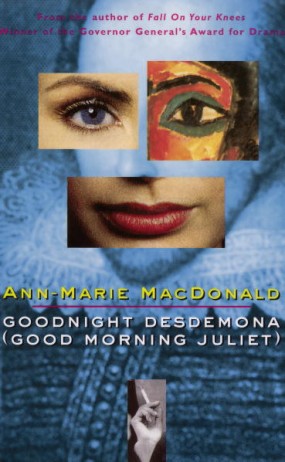- Title: Consider why MacDonald might choose to pair two popular Shakespearean characters and their tragedies? What does the title of this play connote for readers, even before entering the work? How does this frame the narrative and its focus?
- Epigraph: What is the significance of the C.G. Jung epigraph for the play:
The individual, on his lonely path, needs a secret; … a secret which he cannot betray—one which he fears to give away, or which he cannot formulate into words, and which therefore seems to belong to the category of crazy ideas ….
How does the play reflect on this passage, and the passage on the play? What are thecrazy ideas
that are hidden away? How does the play reveal such secrets? - Staging: Consider how the stage is used to blend three different worlds in Act 1. How might we interpret this melding of spaces on the stage? How does each space contribute to our understanding of the other two?
- The absent fool: In Act 1.1, Constance focuses on how
in Othello and Romeo and Juliet the Fool is conspicuous by his very absence, for these two tragedies turn on flimsy mistakes—a lost hanky, a delayed wedding announcement—mistakes too easily concocted and corrected by a Wise Fool … a missing fool … although a Fool might stem the blundering of Othello and Romeo, the questions remains, would he prove a match … for Desdemona and Juliet?
Consider how the remainder of the play explores this question.
- Transformation: Consider how Constance’s process of uncovering the identity of the Author leads to complicating her own identity. Which names and designations does she contest being given, and which does she accept? How does Constance transform from the beginning to the end of the play?
- Intertext: How might MacDonald’s play comment on its two canonical precursors? How does the contemporary play comment on Shakespeare as a participant in a dramatic tradition by suggesting that he is a thief/plagiarist rather than a patriarch of English literature? How does this suggestion reflect ironically upon MacDonald as a writer
stealing
from a notable source? What does this say about literary creativity, authenticity, and genius? After all, MacDonald won a top award for this play, indicating her status as an important playwright as well. - Shakespeare: Elaborate on Melanie Stevenson’s summation of MacDonald’s play:
she invoked a literary icon (Shakespeare) in Goodnight Desdemona in order to challenge patriarchal interpretations of women’s roles in both real life and art
(Stevenson 38). How does MacDonald accomplish this challenge through her use of Shakespeare and these specific plays? - Gender norms: Consider how MacDonald pervasively uses dramatic irony—having a character reveal something opposite to her intentions through knowledge possessed only by the audience—to explore gender norms and various facets of sexual expression and gender performance. Focus on one of the two plays within the play, either the interventions in Othello (Act 2) or in Romeo and Juliet (Act 3). Possible foci could include:
- The use of sexual innuendo, bravado, and hyper-masculine imagery, actions, and scenes, such as in Romeo’s list of morning events given to Juliet in 3.2, or in the observations and actions of Tybalt.
- The mis-attribution of sex, with Constance being recognized as a boy but self-identifying as a woman (beginning of 3.1), and with Romeo’s homoerotic attraction to Constantine, ironically revealed in various ways, but especially voiced in 3.2:
I’ll to my closet straight
andit is my sex that is thine enemy.
- Sources: Consider how this play manipulates the two Shakespearean sources, by placing an interactive frame around them in Act 1, and by later placing them into dialogue with an impostor, Constance. What is revealed through the re-presentation of these sources in this new forum? More specifically, discuss the importance of why MacDonald re-attributes dialogue from male to female and female to male speakers in re-writing both plays (source dialogue [i.e. from the Shakespearean original] is indicated by italicization).
Works Cited
- MacDonald, Ann-Marie. Goodnight Desdemona (Good Morning Juliet). Toronto: Vintage Canada, 1990. Print.
- Stevenson, Melanie A.
Othello, Darwin, and the Evolution of Race in Ann-Marie MacDonald’s Work.
Canadian Literature 168 (2001): 34–54. Print. (PDF)









 ©
©